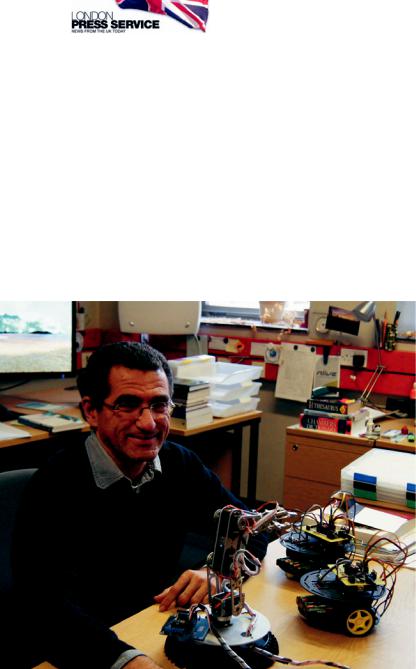
- •NEWS IN BRIEF
- •TEXTS FOR READING
- •Juvenile Delinquency
- •Numbats and Wandoo Trees
- •METHODS OF TEACHING
- •CLASSROOM ACTIVITIES
- •Good Friends Help You Live Longer
- •CREATIVE WRITING
- •Friendship
- •FOCUS ON LANGUAGE
- •Strange Friends
- •TEACHERS FORUM
- •LESSON PLANS
- •TOPICAL JOURNEY
- •Friendship Day
- •Importance of Friendship in Bible
- •Friendship Stories
- •Symbols of Friendship
- •Friendship Literature
- •Shakespeare Quotations on Friendship
- •Letter Writing
- •Idioms about friendship
- •Email Etiquette
- •FOCUS ON LITERATURE
- •SCHOOL THEATRE
- •Six Friends
- •Five-Minute Tests
- •YOUTH ENGLISH SECTION
- •Compliments

English |
|
|
TEXTS FOR READING |
|
4 |
|
|
|
|
|
WE COULD CONVERSE |
|||
February 2013 |
|
|||
|
||||
WITH ROBOTS IN A FEW YEARS
Can we talk? – Dr. Wamberto Vasconcelos thinks our relationship with machines could be more conversational, increasing efficiency.
Image: Aberdeen University
Scientists believe that we could soon be able to talk with robots – thanks to the development of a new generation of software.
Researchers at the University of Aberdeen, Scotland, say this could be used in key industry sectors including aerospace, aviation, defence, and energy generation and supply to greatly reduce mistakes and speed production.
The UK team behind the development – funded by a 1.1 million pounds grant from the Engineering & Physical Sciences Research Council – say they hope the new systems will build trust between machines and humans and increase efficiency, operationally and fi- nancially.
Dr. Wamberto Vasconcelos, from the university’s School of Natural and Computing Sciences, said the software could be ready in fewer than three years, adding: “Autonomous systems – such as robots – are an integral part of modern industry, used to carry out tasks without continuous human guidance.”
The systems use technology called natural language generation, by which complex information and data are translated into simple text summaries. Using a keyboard, a human
being can then further interrogate the computer, asking it to provide further justifications for its decisions, or provide additional information for the computer to integrate into its plans.
A human could also suggest alternatives or point out issues with the chosen course of action, all with the aim of ensuring a positive outcome from the project that is being worked on.
Dr. Vasconcelos explained: “Information and data created by the system, originally represented as symbols of mathematical logic, is automatically transformed into a simple text which can be easily understood by humans.”
This enables the system and a human to discuss a plan before a task – such as dismantling a nuclear plant – is undertaken.
Dr. Vasconcelos continued: “Employed across a variety of sectors, these systems can quickly process huge amounts of information when deciding how to act. However, in doing so, they can make mistakes which are not obvious to them or to a human.”
Evidence shows there may be mistrust when there are no provisions to help a human to understand why an autonomous system has decided to perform a specific task, at a particular time, and in a certain way.
“What we are creating is a new generation of autonomous systems which are able to carry out a two-way communication with humans,” he added.
“The ability to converse with such systems will provide us with a novel tool to quickly understand, and if necessary correct, the actions of an automated system, increasing our confidence in, and the usefulness of, such systems.”
Dr. Vasconcelos concluded: “We hope the systems we are developing will enable a new generation of computer systems – including robots and also potentially mobile phones
– which can interact with a human in useful ways, which up until now haven’t been explored.”
“The resulting systems would potentially enhance efficiency – both in terms of cost and operation – in the sectors in which they could be employed.”
By Ray Cooling
